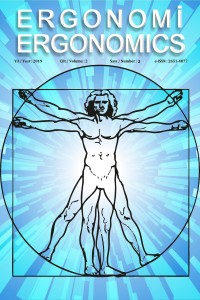Öz
İnsan faktörleri ve
ergonomi konusu ilk kez gündeme geldiği zamanlarda günümüzde algılandığı şekli
ile mental iş yükünün ve yorgunluğun dikkate alınması açısından biraz farklılık
göstermektedir. Ergonomi bilimi çoğu araştırmacı için daha çok fiziksel iş çevresini
dikkate alarak, verimlilik ile ilgili konular üzerinde yoğunlaşan bir bilim
olarak görülmüştür. Ancak zaman içerisinde birçok bilim dalında olduğu gibi ergonomi
biliminde de çağın ve teknolojinin getirdiği yenilikler ve ihtiyaçların da
etkisi ile birtakım ilerlemeler, değişimler ve yenilenmeler söz konusu
olmuştur. Mental yorgunluk ile mental iş yükünün ölçülmesi ve gerek üretim
gerekse de hizmet sistemlerinde bu parametrelerin planlama ve iş süreçlerine
dahil edilmesi konusunda çalışmalar son yıllarda nöroergonomi başlığı ile
literatürde kendisine yer edinmiştir. Bu çalışmanın amacı literatüre yeni
girmesine rağmen, akademik çevrelerden oldukça yoğun ilgi gören nöroergonomi
konusunda yapılan çalışmaların incelenmesi, literatürün ilerlediği ve geldiği
yerin belirlenmesi ile muhtemel çalışma alanlarının ortaya konulması şeklinde
ifade edilebilir. Bu amacı gerçekleştirmek için literatürde yer alan nöroergonomi
konusundaki ulusal ve uluslararası çalışmalar kapsamlı şekilde incelenmiş,
konuyu ele alma biçimlerine, uygulama alanlarına, ölçüm yöntemlerine ve benzeri
kriterlere göre sınıflandırılarak analiz edilmiştir
Anahtar Kelimeler
Kaynakça
- Aghajani, H., Garbey M, and Omurtag A, (2017). Measuring Mental Workload with EEG+fNIRS. Frontiers in Human Neuroscience. 11, 359.
- Aydoğan, E.K., Bıyıklı, Ö., (2015).Nöroergonomi ve Temel Uygulama Alanları, Süleyman Demirel Üniversitesi Mühendislik Bilimleri ve Tasarım Dergisi 3(3),ÖS:Ergonomi2015, 173-179.
- Borghetti, B.J., Giametta, J.J., Rusnock, C.F.,(2017). Assessing Continuous Operator Workload With a Hybrid Scaffolded Neuroergonomic Modeling Approach. Human Factors. 59(1),134-146.
- Berka, C., Levendowski, D.J., Lumicao, M.N., Yau, A., Davis, G., Zivkovic, V.T., Olmstead, R.E., Tremoulet, P.D., and Craven, P.L. (2007). EEG correlates of task engagement and mental workload in vigilance, learning, and memory tasks. Aviaton Space Environmet Med. 78(5),B231-44.
- Causse, M., Dehaisa, F., Péran, P., o Sabatini, U., Pastorb, J., (2013). The effects of emotion on pilot decision-making: A neuroergonomic approach to aviation safety ,Transportation Research Part C: Emerging Technologies. 33, 272-281.
- Causse, M., Peysakhovich, V., and Fabre, E., (2016). High Working Memory Load Impairs Language Processing during a Simulated Piloting Task: An ERP and Pupillometry Study, Frontiers in Human Neuroscience. 10, 240.
- Di Stasi, L., Antolía, A., Geab, M., Cañas, J., (2011). A neuroergonomic approach to evaluating mental workload in hypermedia interactions, International Journal of Industrial Ergonomics 41 (3), 298-304.
- Di Stasi, L., Diaz-Piedra, C., Suárez, J., McCamy, M.B., Martinez-Conde, S., Roca-Dorda, J., Catena, A.,(2015). Task complexity modulates pilot electroencephalographic activity during real flights. Psychophysiology. 52(7),951-956.
- Delice, E.K., (2016). Acil Servis Hekimlerinin Nasa-Rtlx Yöntemi İle Zihinsel İş Yüklerinin Değerlendirilmesi: Bir Uygulama Çalışması, Atatürk Üniversitesi İktisadi ve İdari Bilimler Dergisi, 30(3), 645-662.
- Giraudet, L., Imbert, J.P., Bérenger, M., Tremblay, S., Causse, M., (2015). The neuroergonomic evaluation of human machine interface design in air traffic control using behavioral and EGG/ERP measures. Behavioural Brain Research,1,294, 246-253.
- Hanckok., P.A., Szalma, J.l., (2003). The future of neuroergonomics, Theorotical Issues in Ergonomics Science, 4(1-2), 238-249.
- Kosti, M., Georgiadis, K., Adamos, D., Laskaris, N., Spinellis, N., Angelis, L., (2018).Towards an affordable brain computer interface for the assessment of programmers’ mental workload, International Journal of Human-Computer Studies, 115, 52-66.
- Liu, Y., Subramaniam, S., Sourina, O., Hui, S., Liew, P., Krishnan, G., Konovessis, D., Ang, H. (2017). EEG-based Mental Workload and Stress Recognition of Crew Members in Maritime Virtual Simulator: A Case Study, International Conference on Cyberworlds (CW).
- Mehta, R.K., Parasuraman, R., (2014).Effects of mental fatigue on the development of physical fatigue: a neuroergonomic approach, Human factors, 56 (4), 645-656.
- Mijović, P., (2018).Introductıon To The Emergıng Fıeld Of Neuroergonomıcs‐Promıses And Challenges, Irish Ergonomics Review, 23-29.
- Özkara, B.Y., Nöropazarlamada Elektroensefalografi (EEG) Kullanımı Ekin Yayınevi, Bursa, 2017
- Ranjana, M., Parasuraman, R., (2013). Effects of Mental Fatigue on the Development of Physical Fatigue A Neuroergonomic Approach, Human Factors The Journal of the Human Factors and Ergonomics Society 56(4).
- Roy, R. N., Bonnet, S., Charbonnier, S., Jallon, P., Campagne, A., (2015). A comparison of ERP spatial filtering methods for optimal mental workload estimation. Conference Proceeding IEEE Engineering in Medicine and Biology Society. 7254-7
- Parasuraman, R.,(2003). Neuroergonomics: Research and practice. Theoretical issues in ergonomics science, 4 (1-2), 5-20.
Ayrıntılar
| Birincil Dil | Türkçe |
|---|---|
| Bölüm | Derleme Makaleleri |
| Yazarlar | |
| Yayımlanma Tarihi | 1 Ağustos 2019 |
| Gönderilme Tarihi | 15 Kasım 2018 |
| Yayımlandığı Sayı | Yıl 2019 Cilt: 2 Sayı: 2 |
Cited By
A Systematic Review of Cognitive Ergonomics And Safety: General Trends And Application Areas
Gazi Üniversitesi Fen Bilimleri Dergisi Part C: Tasarım ve Teknoloji
https://doi.org/10.29109/gujsc.1378288
Dergi yılda 3 sayı (Nisan, Ağustos ve Aralık) olarak yayımlanmaktadır. Bu sayılara ek olarak Editörler Kurulu’nun kararıyla, Ulusal Ergonomi Kongresi’nde sunulan bildiriler “Özel Sayı” olarak yayımlanabilmektedir.


